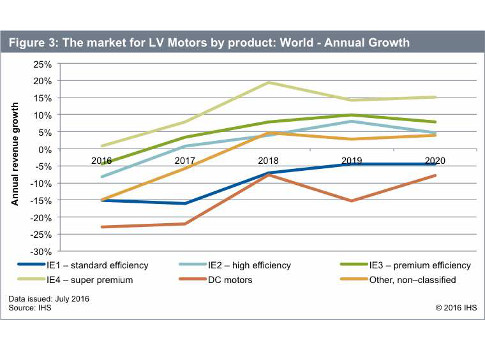IHS Markit projects that revenues for the low-voltage motor market will decline in 2017, but there are signs that it will rebound over the next several years thanks to technology developments such as the Industrial Internet of Things (IIoT) being used in the market.

Since the third quarter of 2014, the low-voltage motor market (i.e., integral horsepower motors rated at or below 690 V) has struggled amid the numerous economic and political headwinds. The global low-voltage motor market will decline nearly 13%, from $11.8 billion in sales in 2015 to $10.3 billion in 2017, according to IHS Markit’s projections.
Despite this challenging environment, there are opportunities for motor suppliers that can adapt to the impending technological trends suppliers require. For example, motor end-users are increasingly interested in energy-efficient motors that will live longer and reduce full lifecycle costs. As the Industrial Internet of Things (IIoT) continues to grow in customer recognition and adoption, motor manufacturers are also starting to find ways to leverage this trend to offset weak sales.
While there are reasons to be optimistic, the current political turmoil certainly harms growth prospects for the entire industrial automation equipment market throughout the next two-to-three years. As the global economy adjusts and recovers from shocking events, such as the British exit of the European Union and stalling oil prices, the low-voltage motor market revenue will decline very slightly, at a compound annual growth rate (CAGR) of negative 0.2% from 2015 to 2020. However, a strong recovery is expected to begin in 2018.
While heavy industries exposed to oil and gas investment levels are not currently good areas for motor growth, there are still several industry sectors that have outperformed—or that will outperform—the market average in the short-term. For example, the U.S. housing market is expected to experience strong growth, as is non-residential construction spending, which bodes well for motors sold into construction, infrastructure, and HVAC applications.
A fast-growing population and rapid urbanization is also expected to cause motor shipments for food and beverage, water and wastewater, and power sectors to outperform the market average. In general the discrete manufacturing (machine builder) sectors are forecast to perform better than the process manufacturing (end-user) sectors.
Figures 1 and 2 demonstrate the growth rates for key industries.
After accounting for more than 26% of revenues in 2015, IE1 (standard efficiency) motors are forecast to comprise 25% of global low-voltage motor market revenue in 2016, and 16% by 2020. These products are sold mainly in the emerging markets that have yet to adopt any type of efficiency regulations; however, many leading suppliers are still successfully selling these motors in the United States, Germany and other developed countries.
As emerging and developed regions continue to push for more efficient motors, IE2 (high efficiency), IE3 (premium efficiency), and IE4 (super-premium efficiency) motors will continue to experience growth with revenue CAGRs of 1.6%, 4.8%, and 11.3%, respectively. It is worth noting, however, that IE4 motors accounted for slightly more than 1% of total motor market revenues. Therefore, it will take a long time for this technology to be considered a dominant customer trend.
Figure 3 highlights the growth trends of all products considered in the most recent IHS Markit research conducted for these products.
Despite the ominous forecast for low-voltage motors through 2020, there are still ample opportunities for manufacturers to maintain-and even grow-their existing client base, through the adoption of the technological advancements end-users are beginning to require more frequently. Acquisitions and strategic partnerships, in conjunction with increased research and development investments, have allowed the leading motor manufacturers to better position themselves for the future. Even though the low-voltage motor market is not currently thriving, today’s technological developments could be the norm for motor users in the near future—but only the companies that can adapt will be prepared for such rapid changes.
Preston Reine, senior analyst, IHS Markit. IHS Markit is a CFE Media content partner. Edited by Chris Vavra, production editor, CFE Media, [email protected].
– See additional stories linked below.
ONLINE extra
See additional stories from IHS linked below.



